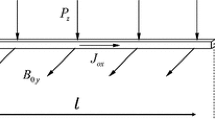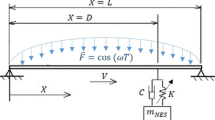Abstract
In this paper, the magneto-elastic superharmonic-principal parametric joint resonance of an axially variable-speed moving beam is investigated, where magnetic force generated by parallel current-carrying wires is considered. Based on electromagnetic theory and Hamilton principle, the nonlinear forced vibration equation is derived, and the vibration differential equation is obtained using the Galerkin method. The multiple-scale method is used to solve the differential equation for the analytical solution, and the stability of the steady-state solutions is analyzed. Through an example, the curves of amplitude versus frequency, external excitation, axial velocity, current intensity, and beam position are obtained. The results show that the effect of axial velocity on resonance frequency is significantly larger than that of current intensity. In addition, the increase in current intensity leads to the decrease in amplitude, since the current-carrying wires act as electromagnetic damping. As the current intensity increases and the distance decreases, respectively, the system changes from quasi-periodic motion to single-frequency periodic motion.













Similar content being viewed by others
References
Marynowski, K., Kapitaniak, T.: Zener internal damping in modelling of axially moving viscoelastic beam with time-dependent tension. Int. J. Non-Linear Mech. 42(1), 118–131 (2007)
Chen, L.Q., Tang, Y.Q.: Combination and principal parametric resonances of axially accelerating viscoelastic beams: recognition of longitudinally varying tensions. J. Sound Vib. 330, 5598–5614 (2011)
Parker, R.G., Lin, Y.: Parametric instability of axially moving media subjected to multifrequency tension and speed fluctuations. J. Appl. Mech. 68(1), 49–57 (2001)
Ghayesh, M.H., Balar, S.: Non-linear parametric vibration and stability of axially moving visco-elastic Rayleigh beams. Int. J. Solids Struct. 45, 6451–6467 (2008)
Tang, Y.Q., Chen, L.Q., Zhang, H.J., Yang, S.P.: Stability of axially accelerating viscoelastic Timoshenko beams: recognition of longitudinally varying tensions. Mech. Mach. Theory 62(4), 31–50 (2013)
Ravindra, B., Zhu, W.D.: Low-dimensional chaotic response of axially accelerating continuum in the supercritical regime. Arch. Appl. Mech. 68, 195–205 (1998)
Chakraborty, G., Mallik, A.K.: Parametrically excited non-linear traveling beams with and without external forcing. Nonlinear Dyn. 17(4), 301–324 (1998)
Ӧz, H.R., Pakdemirli, M.: Vibrations of an axially moving beam with time-dependent velocity. J. Sound Vib. 227(2), 239–257 (1999)
Ӧz, H.R., Pakdemirli, M., Boyacɪ, H.: Non-linear vibrations and stability of an axially moving beam with time-dependent velocity. Int. J. Non-Linear Mech. 36, 107–115 (2001)
Feng, Z.H., Hu, H.Y.: Dynamic stability of a slender beam with internal resonance under a large linear motion. Chin. J. Theor. Appl. Mech. 34(3), 389–400 (2002)
Tang, Y.Q., Zhou, Y., Liu, S., Jiang, S.Y.: Complex stability boundaries of axially moving beams with interdependent speed and tension. Appl. Math. Model. 89, 208–224 (2021)
Tang, Y.Q., Zhang, D.B., Gao, J.M.: Parametric and internal resonance of axially accelerating viscoelastic beams with the recognition of longitudinally varying tensions. Nonlinear Dyn. 83(1–2), 401–418 (2016)
Zhang, D.B., Tang, Y.Q., Liang, R.Q., Yang, L., Chen, L.Q.: Dynamic stability of an axially transporting beam with two-frequency parametric excitation and internal resonance. Eur. J. Mech./A Solids. 85, 104084 (2021)
Sahoo, B., Panda, L.N., Pohit, G.: Combination, principal parametric and internal resonances of an accelerating beam under two frequency parametric excitation. Int. J. Non-Linear Mech. 78, 35–44 (2016)
Lv, H.W., Li, L., Li, Y.H.: Non-linearly parametric resonances of an axially moving viscoelastic sandwich beam with time-dependent velocity. Appl. Math. Model. 53, 83–105 (2018)
Ding, H., Huang, L.L., Earl, D., Chen, L.Q.: Stress distribution and fatigue life of nonlinear vibration of an axially moving beam. Sci. China Technol. Sci. 62(7), 1123–1133 (2019)
Hu, Y.D., Wang, J.: Principal-internal resonance of an axially moving current-carrying beam in magnetic field. Nonlinear Dyn. 90(1), 683–695 (2017)
Hu, Y.D., Zhang, L.B.: Magneto-elastic vibration equations for axially moving conductive and magnetic beams. Appl. Math. Mech. 36(1), 70–77 (2015)
Hu, Y.D., Rong, Y.T.: Primary parametric resonance of an axially accelerating beam subjected to static loads. J. Theor. Appl. Mech. 56(3), 815–828 (2018)
Nayak, B., Dwivedy, S.K., Murthy, K.S.R.K.: Dynamic analysis of magnetorheological elastomer-based sandwich beam with conductive skins under various boundary conditions. J. Sound Vib. 330(9), 1837–1859 (2011)
Pratiher, B., Dwivedy, S.K.: Parametric instability of a cantilever beam with magnetic field and periodic axial load. J. Sound Vib. 305(4–5), 904–917 (2007)
Pratiher, B.: Non-linear response of a magneto-elastic translating beam with prismatic joint for higher resonance conditions. Int. J. Non-Linear Mech. 46(5), 685–692 (2011)
Zheng, X.J., Liu, X.E.: Analysis on dynamic characteristics for ferromagnetic conducting plates in a transverse uniform magnetic field. Acta Mech. Solida Sin. 21(3), 243–250 (2000)
Wang, L., Chen, H.H., He, X.D.: Active H͚ control of the vibration of an axially moving cantilever beam by magnetic force. Mech. Syst. Signal Process. 25(8), 2863–2878 (2011)
Guo, S.H.: Electrodinamics. China Higher Education Press, Beijing (1997)
Cao, Z.Y.: Vibration Theory of Plates and Shells, p. 445. China Railway Publishing House, Beijing (1983)
Nayfeh, A.H., Mook, D.T.: Nonlinear Oscillations. Wiley, New York (1995)
Acknowledgements
The authors gratefully acknowledge the financial supports from the National Natural Science Foundation of China with Grant No. 12172321, Hebei Provincial Natural Science Foundation of China with Grant No. A2020203007.
Author information
Authors and Affiliations
Corresponding author
Ethics declarations
Conflict of interest
On behalf of all authors, the corresponding author states that there is no conflict of interest.
Additional information
Publisher's Note
Springer Nature remains neutral with regard to jurisdictional claims in published maps and institutional affiliations.
Appendices
Appendix A:Integral coefficient expression
\(A_{11} = \int_{0}^{l} {\frac{{{\text{d}}^{4} X_{1} }}{{{\text{d}} x^{4} }}} X_{1} {\text{d}} x\), \(B_{11} = \int_{0}^{l} {\frac{{{\text{d}}^{2} X_{1} }}{{{\text{d}} x^{2} }}} X_{1} {\text{d}} x\), \(C_{11} = \int_{0}^{l} {\frac{{{\text{d}} X_{1} }}{{{\text{d}} x}}} X_{1} {\text{d}} x\), \(D_{11} = \int_{0}^{l} {X_{1} } X_{1} {\text{d}} x\), \(E_{1} = \int_{0}^{l} {X_{1} } {\text{d}} x\), \(H_{11} = \int_{0}^{l} {X_{1}^{2} X_{1} {\text{d}} x}\)\(K_{11} = \int_{0}^{l} {\frac{{{\text{d}} X_{1} }}{{{\text{d}} x}}X_{1} } X_{1} {\text{d}} x\), \(M_{11} = \int_{0}^{l} {X_{1}^{3} X_{1} {\text{d}} x}\), \(N_{11} = \int_{0}^{l} {\frac{{{\text{d}} X_{1} }}{{{\text{d}} x}}} X_{1}^{2} X_{1} {\text{d}} x\), \(S_{11} = \int_{0}^{l} {\frac{{{\text{d}}^{2} X_{1} }}{{{\text{d}} x^{2} }}\left( {\frac{{dX_{1} }}{dx}} \right)}^{2} X_{1} {\text{d}} x\).
Appendix B: The parameters in Eq. (10)
\(q_{1} (\tau ) = \frac{{q_{1} (t)}}{h}\), \({\kern 1pt} {\kern 1pt} {\kern 1pt} {\kern 1pt} \omega_{0} = p_{1}^{2} \sqrt {\frac{EI}{{\rho A}}{\kern 1pt} } {\kern 1pt}\), \({\kern 1pt} {\kern 1pt} {\kern 1pt} \tau = {\kern 1pt} \omega_{0} t{\kern 1pt}\), \({\kern 1pt} \eta = \frac{{c_{0} }}{{\omega_{0} }}\), \(\zeta = \frac{{F_{o} }}{{\rho A\omega_{0}^{2} }}\), \(\mu_{11}^{\prime } = \frac{{2c_{1} C_{11} }}{{\omega_{0} D_{11} }}\), \(\mu_{11} = \frac{{\sigma_{0} \mu_{0}^{2} \alpha_{1}^{2} D_{11} }}{{4{\uppi }^{2} \rho \omega_{0} D_{11} }} + \frac{{2c_{0} C_{11} }}{{\omega_{0} D_{11} }}\), \(g_{1}^{2} = \frac{{\eta^{2} B_{11} }}{{D_{11} }} - \frac{{\zeta B_{11} }}{{D_{11} }} + \frac{{EIA_{11} }}{{\rho A\omega_{0}^{2} D_{11} }} + \frac{{\mu_{0}^{2} \sigma_{0} \alpha_{1}^{2} c_{0} C_{11} }}{{4{\uppi }^{2} \rho \omega_{0}^{2} D_{11} }} + \frac{{c_{1}^{2} B_{11} }}{{2\omega_{0}^{2} D_{11} }}\), \({\kern 1pt} \Omega_{1} = \frac{{\omega_{1} }}{{\omega_{0} }}\), \({\kern 1pt} \Omega_{2} = \frac{{\omega_{2} }}{{\omega_{0} }}\), \({\kern 1pt} \Omega_{3} = \frac{{\omega_{3} }}{{\omega_{0} }}\),\(\delta_{111} = \frac{{\mu_{0}^{2} \sigma_{0} \alpha_{1}^{2} c_{1} C_{11} }}{{4{\uppi }^{2} \rho \omega_{0}^{2} D_{11} }} + \frac{{2c_{0} c_{1} B_{11} }}{{\omega_{0}^{2} D_{11} }}\),
\(\delta_{211} = \frac{{c_{1}^{2} B_{11} }}{{2\omega_{0}^{2} D_{11} }}\), \(\delta_{311} = \frac{{ - F_{1} B_{11} }}{{\rho A\omega_{0}^{2} D_{11} }}\), \(\delta_{411} = \frac{{ - c_{1} C_{11} }}{{\omega_{0} D_{11} }}\), \(\chi_{11} = \frac{{\mu_{0}^{2} \sigma_{0} \alpha_{2} c_{0} hK_{11} }}{{4{\uppi }^{2} \rho \omega_{0}^{2} D_{11} }}\), \(\chi_{11}^{\prime } = \frac{{\mu_{0}^{2} \sigma_{0} \alpha_{2} c_{1} hK_{11} }}{{4{\uppi }^{2} \rho \omega_{0}^{2} D_{11} }}\), \({\kern 1pt} n_{11} = \frac{{\mu_{0}^{2} \sigma_{0} \alpha_{3} c_{0} h^{2} N_{11} }}{{4{\uppi }^{2} \rho \omega_{0}^{2} D_{11} }} - \frac{{3ES_{11} h^{2} }}{{2\rho \omega_{0}^{2} D_{11} }}\), \({\kern 1pt} n_{11}^{\prime } = \frac{{\mu_{0}^{2} \sigma_{0} \alpha_{3} c_{1} h^{2} N_{11} }}{{4{\uppi }^{2} \rho \omega_{0}^{2} D_{11} }}\), \(h_{11} = \frac{{\mu {}_{0}^{2} \sigma_{0} \alpha_{2} H_{11} h}}{{4{\uppi }^{2} \rho D_{11} \omega_{0} }}\), \(m_{11} = \frac{{\mu_{0}^{2} \sigma_{0} \alpha_{3} M_{11} h^{2} }}{{4{\uppi }^{2} \rho D_{11} \omega_{0} }}\), \(f_{1} = \frac{{P_{0} E_{1} }}{{D_{11} \rho \omega_{0}^{2} hA}}\).
Appendix C: The parameters in Eq. (25)
\(+ \frac{{\mu_{11}^{\prime } }}{4}g_{1} \cos 2\phi_{40} - \frac{{\delta_{311} }}{4}\sin 2\phi_{40} ]\),
\(j_{12} = \frac{1}{{g_{1} }}\left[ { - 2\gamma_{20} \cos 2\phi_{40} + 2\gamma_{70} \sin 2\phi_{40} - 2\gamma_{30} \cos 2\phi_{40} - \gamma_{40} \cos \phi_{40} + \gamma_{50} \sin \phi_{40} - \gamma_{60} \cos \phi_{40} } \right]\),
\(j_{21} = \frac{1}{{g_{1} }}\left[ { - \left( {\frac{3}{4}n_{11} a_{10} } \right) - \left( {\frac{{3n_{11}^{\prime } }}{8}a_{10} } \right)\cos 2\phi_{40} + n_{11} \Lambda_{1}^{3} \frac{1}{{a_{10}^{2} }}\cos \phi_{40} - m_{11} \Lambda_{1}^{3} \Omega_{3} \frac{1}{{a_{10}^{2} }}\sin \phi_{40} + \frac{{n^{\prime}_{11} }}{2}\Lambda_{1}^{3} \frac{1}{{a_{10}^{2} }}\cos \phi_{40} } \right]\),
\(j_{22} = \frac{1}{{a_{10} g_{1} }}\left[ {2\gamma_{20} \sin 2\phi_{40} + 2\gamma_{70} \cos 2\phi_{40} + 2\gamma_{30} \sin 2\phi_{40} + \gamma_{40} \sin \phi_{40} + \gamma_{50} \cos \phi_{40} + \gamma_{60} \sin \phi_{40} } \right]\),
\(\gamma_{50} = m_{11} \Lambda_{1}^{3} \Omega_{3}\), \(\gamma_{60} = \frac{{n^{\prime}_{11} }}{2}\Lambda_{1}^{3}\), \(\gamma_{70} = - \frac{{\mu_{11}^{\prime } }}{4}a_{10} g_{1}\), \(\gamma_{20} = \frac{{\delta_{111} }}{4}a_{10} + \frac{{3n_{11}^{\prime } }}{16}a_{10}^{3} + \frac{{3n_{11}^{\prime } }}{2}a_{10} \Lambda_{1}^{2}\), \(\gamma_{30} = \frac{{\delta_{311} }}{4}a_{10}\), \(\gamma_{40} { = }n_{11} \Lambda_{1}^{3}\).
Rights and permissions
Springer Nature or its licensor holds exclusive rights to this article under a publishing agreement with the author(s) or other rightsholder(s); author self-archiving of the accepted manuscript version of this article is solely governed by the terms of such publishing agreement and applicable law.
About this article
Cite this article
Li, XJ., Hu, YD. & Li, WQ. Superharmonic-principal parametric joint resonance and stability of an axially variable-speed moving beam between current-carrying wires. Arch Appl Mech 92, 3897–3912 (2022). https://doi.org/10.1007/s00419-022-02270-7
Received:
Accepted:
Published:
Issue Date:
DOI: https://doi.org/10.1007/s00419-022-02270-7




